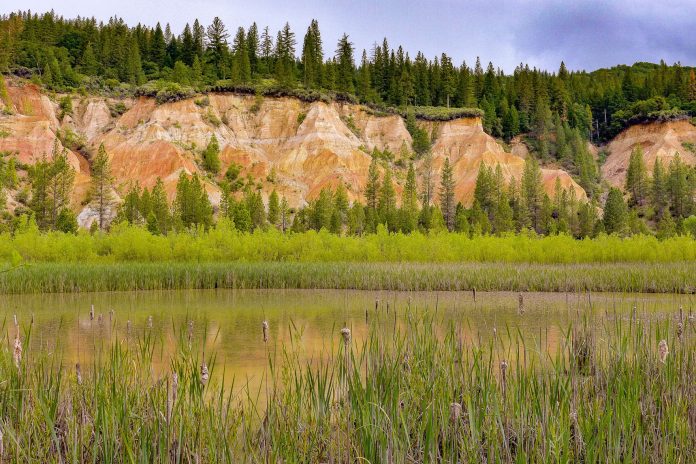
<
The first prospectors to arrived in California after James Marshall’s discovery of gold at Sutter’s Mill struck pay dirt with relative ease. Through panning and light placer mining techniques, miners could harvest gold that had washed into the creek beds. After only a few years, most of the easily reached gold was gone.
<
The Sierra foothills still held great riches, but it would require the capital and machinery of big industry to unearth them. One of those industrial methods was hydraulic mining. Water channeled from dams built in the hills above traveled through flumes and pipes, gaining speed and power along the way, to huge nozzles that washed away hillsides and exposed hidden gold. Malakoff Mine above Nevada City was the world’s largest hydraulic operation. I recently visited Malakoff Diggins State Park to see the scarred pit the miners left behind and visit the remains of North Bloomfield, the town that grew up around it.
<
The serpentine road to the park made the drive from Nevada City seem much longer than 26 miles. Main Street was quiet on this rainy and very peaceful Saturday. I spent some time wandering among the empty homes and businesses in downtown North Bloomfield, then moved on to the Diggins a half-mile down the road.
<
Only a few paces below the road, I stepped on to the Diggins Loop Trail. As its name suggests, the two and a half mile trail circles the perimeter of the vast scar left by the hydraulic operations. If no hydraulic mining had been done here, the wooded slopes above would have continued their steady drop to Humbug Creek. Instead, those slopes have been washed away opening a huge amphitheater surrounded by naked red-hued cliffs of loose rock and gravel.
<
My first steps on the trail were on the lower stretches of the washed-away hills. Above, on the bare slope, an occasional dwarf pine struggled for life. As I reached the valley floor, I stepped past rusted mining equipment and zigzagged through an endless maze of manzanita and willow.
<
The 1.5 billion yards of silt washed downstream by hydraulic mining in California—eight times the amount excavated in the Panama Canal—created flooding and havoc downstream. The silt buried Marysville and Yuba City under 25 feet of sludge, and in 1866 it was estimated that San Francisco Bay was filling at a rate of one foot per year.
<
Despite the legacy of destruction here, the landscape was beautiful and interesting. Edges, the boundary between different landscapes, always seem to have a special beauty. This juxtaposition of coniferous forest and recovering devastation was no exception. I never grew tired of looking at the willows, then the pines, rising in a tiered foreground beneath a red-orange wall of rock. Even Diggins Lake, surrounded by cattails and reeds, added to the amphitheater’s silent beauty.
<
With thirty family campsites and three miner’s cabins that can be reserved, 3,143-acre Malakoff Diggins State Historic Park is perfect for a day visit or an extended stay.
<
I never grew tired of looking at the willows, then the pines, rising in a tiered foreground beneath a red-orange wall of rock.







